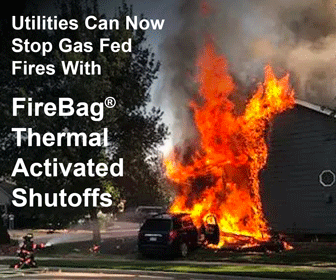Need for Thermal Gas Shutoff National Regulation
Teco Americas urges United States Pipeline and Hazardous Materials Safety Administration (PHMSA) to include the use of Thermally Activated Gas Shutoffs (TAS), sometimes referred to as Thermally Activated Gas Shutoffs in their regulation 49 CFR 192 for gas distribution piping systems. Thermally Activated Shutoffs are already in use by some gas utilities in the U.S., are readily available, and are in prevalent use in gas systems around the world, many being required by code.
Doug Staebler testified to the critical need of these safety devices from his experience based on his more than 40 years of extensive experience in Gas Utility Operations, with over 20 of those years in executive leadership positions responsible for the safety and operations of large natural gas distribution systems. “In August of 2016, in my role as Senior Vice President of Operations, I began a 2-years period working closely with PHMSA, as the Party Lead for the Utility, in the investigation of the incident at the Flower Branch Apartments in Silver Spring, Maryland,” he explains. “This tragic event still weighs heavily on me and has only heightened my commitment to improving safety for all stakeholders in natural gas supply and delivery.”
The Nation Transportation Safety Board (NTSB) also participated in investigating the Flower Branch Apartment incident. Following the detailed investigation, the NTSB recommended adding an additional layer of gas safety such as thermally activated shutoffs to prevent high pressure gas from feeding fires in cases where the gas meter is damaged or compromised during a fire.
Doug Staebler adds, “Through my experience, I also fully support the recommendation made by Washington Gas (WGL), as part of their Party Submittal, regarding the use of Thermally Activated Shutoffs (TAS).” Immediately following the incident, WGL incorporated the use of this TAS technology with all new and replaced gas services, as well as whenever a regulator is relocated to the exterior of a building.
Staebler recalls, “I was on site at Flower Branch immediately following the explosion and was the last person to depart the site when all investigations were complete; I was on site every day, sunup to sundown, and can honestly say I was on site more than any other individual.” He notes, “What was not highlighted in the outcomes of the investigation was the role the gas fire played.”
Immediately following the explosion people were actively entering the partially collapsed structure and rescuing people. As the collapsing structure continued to fail, it soon impacted the gas meter assembly and gas piping in the basement, severing many of the gas lines. This allowed high pressure gas to flow into the basement where it soon found an ignition source and a large gas fire ensued. The heat from this fire halted all rescue efforts and seven people, including two young boys (David and Fernando) were still trapped inside, and ultimately died at the grips of the gas fire; I couldn’t think of a more terrible way to die. If the utility meter assembly in the basement had a TSV, it would have likely been activated by the small fires resulting from the explosion and shut of the gas supply. This would have averted the large gas fire and possibly more lives would have been saved by our First Responders.
In addition to catastrophic incidents like Flower Branch, Maryland, and East Harlem, NYC, and East Village, NYC, there are numerous cases throughout the gas industry where gas-fed fires, primary and secondary, have contributed to significant property damage, as well as loss of life. The National Fire Protection Association (NFPA) research found that an estimated 4,200 home structure fires per year were started with ignition of natural gas and caused an average of 40 deaths. “If a TAS was installed as part of the gas piping system upstream of the meter assembly, many of these would likely have been prevented, and the amount of damage and fatalities would have been greatly reduced. In the wake of all these gas-fed fires, the evidence lockers at every gas utility have a plethora of scorched meter sets.”
Many multi-family buildings, as well as commercial buildings, have gas meters and regulators located inside the structure and this internal gas utility owned piping gives PHMSA jurisdictional responsibility over it. Also, the larger gas load demand of these buildings requires larger volume regulators, as well as larger diameter piping, therefore increasing the level of potential hazard within these types of facilities, regardless of the location of the regulators. Add in the fact that many families and people utilize these buildings every day, we cannot ignore the need to require the use of the highest level of available safety devices.
We encourage our colleagues to submitted comments to PHMSA as part of the 2020 PIPES act proposed rule making process and asks that the NTSB lend their weight to incorporating the use of TASs in the natural gas system as part of the gas utilities codified requirements.
At a minimum, PHMSA should update 49CFR192.353 to require:
- Every new or replaced gas service line to a multifamily building to have a TSV installed upstream of the regulator and meters.
- Over a defined period, require any inside regulator in any multifamily building to be relocated outside where practicable, and be retrofitted with a TSV upstream of the regulator and meters.
- If the regulator is located outside of the building and the meters are inside of the building, there needs to be one (1) TSV outside upstream of the regulator, as well as a second TSV as the first fitting inside the building on the jurisdictional piping upstream of the meter bank.
- This should be considered for all high-occupancy buildings such as schools, hospitals, nursing homes, etc.
- Expand 1 and 2 above to include all residential, commercial, and industrial buildings.
- Every multifamily building must have methane detection technology installed where the gas line enters the building, and where the metering facilities are located within the building.
We fully embrace and appreciate the important role of the NTSB in enhancing safety for the people of the United States, and hope you see the value of strongly communicating the need to require the use of these effective and extremely affordable safety devices.
Resources
Contact Us Today!
All information is confidential and sent directly to a TECO Americas representative.
TECO® Americas, LLC
263 Cox Street Roselle, NJ 07203
inquiry@tecoamericas.com
Phone: 908-488-0909
https://tecoamericas.com


